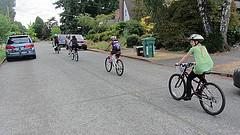
Make it safe for our kids to walk or bike to school
CNU President & CEO Lynn Richards Pens Op-Ed for Greater Greater Washington
Submitted on 10/13/2014. Tags for this image:First week of middle school. First bike ride to school. First near-fatal encounter with the #1 killer of children—cars.
That scary commute was my son's experience when he began the 2014 school year in Arlington County. And it's the same story throughout most US metropolitan areas. Isn't it way past time we grant our children safe passage to school?
Here's a timely opportunity. Today is the annual International Walk and Bike to School Day. Across the country, kids will be encouraged to change their usual routines to walking or biking instead of being chauffeured to school. Yet how can kids take advantage of that choice when we've made the routes between their homes and schools so unsafe? According to a 2014 DOT study, motor vehicle crashes are the leading cause of death for children ages 4 through 14.
Since our Arlington County home is 1.3 miles from my son's middle school, walking and biking are obvious transportation options. Biking with him on his first day, I was surprised to find the roads overwhelmed by cars. At the school's intersection, bike lanes fade into nothingness, leaving young bike riders to determine their own routes.
The school driveway doesn't even have a stop or yield sign, so cars enter the street without pausing, putting bikers and walkers at risk. The congestion and dangers are such that a police officer and a teacher have to oversee the drop-off. But their backs are to the middle school cyclists coming onto the school property.
Street design and schools' transportation management priorities send strong signals to parents and students that cars trump all other modes of getting around. It's an assumption that contributes to the obesity epidemic among our children and to the overall social and economic health of our communities. Childhood obesity now affects one in three children between 2 and 19 and costs the US an estimated $305 billion each year. Research suggests that kids who walk to school have higher overall physical activity throughout the day and better academic performance.
The fact is, neighborhood and street design that encourages more pedestrian and cycling activity is an indicator of health and relative prosperity. Research has shown that GDP per capita in walkable urban metropolitan areas is 38% higher than the average in the 10 least walkable urban metros. Homes in walkable neighborhoodsexperienced less than half the average decline in price from the housing peak in the mid-2000s.
And in the Washington region, each point increase in a walkability measure adds $9 per square foot to annual office rents, $7 per square foot to retail rents, over $300 per month to apartment rents, and nearly $82 per square foot to home values.
If we can't convince ourselves to make it safer to walk or bike for children's health and academic performance, can we do it to bolster our economic bottom lines?
There are a number of easy low-cost design fixes that could send strong signals that school systems prioritize safe walking and biking. Given the costs of traffic congestion management to schools during drop-off and pick-up hours, maybe parents who drive students should have to apply for a permit. Or perhaps blocks surrounding the school could designate pedestrian-only zones at the beginning and end of the school day. Designated bike lanes could be painted on the street. At the very least, the school or county could install stop signs at the ends of school driveways.
A measure of a healthy neighborhood and community is how well people ages 8 to 80 can safely navigate their streets, roads, parks, and public areas. On this national day when we celebrate the benefits of walking and biking to school, shouldn't we be planning better ways to demonstrate our concern for our kids' safety?
This post originally appeared on Greater Greater Washington. See orginal post here: Make it safe for our kids to walk or bike to school



